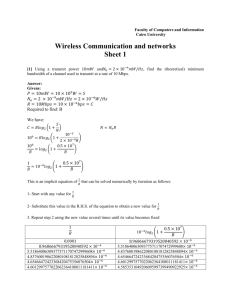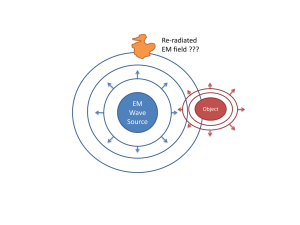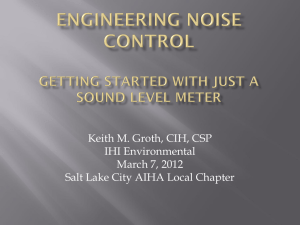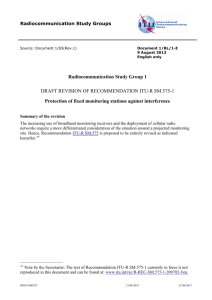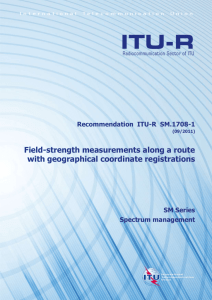Complementary Information To Planning Parameters for Terrestrial
advertisement
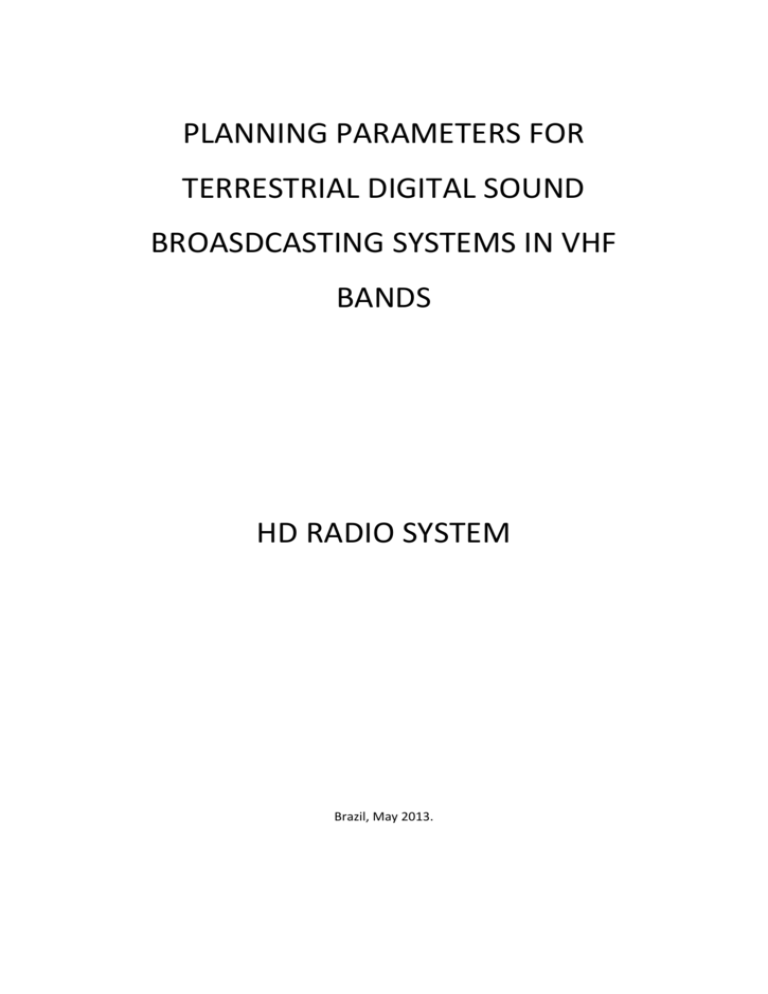
PLANNING PARAMETERS FOR TERRESTRIAL DIGITAL SOUND BROASDCASTING SYSTEMS IN VHF BANDS HD RADIO SYSTEM Brazil, May 2013. This document have been written by Flávio Ferreira Lima from Ministry of Communication in Brazil and revised by Russ Mundschenk from iBiquity Digital Corporation in United States of America. Sumário Introduction ............................................................................................................. 4 1. Receiver noise input power level ..............................................................................4 2. Minimum receiver input power level ........................................................................5 3. Effective antenna aperture .......................................................................................6 4. Minimum power flux-density ....................................................................................6 5. Calculation of minimum RMS ....................................................................................7 6. Calculation of minimum median RMS field-strength level ..........................................7 7. Referências ..............................................................................................................8 Complementary Information To Planning Parameters for Terrestrial Digital Sound Broadcasting Systems in HDRadio Introduction This document describes some parameters that will be very important to close the planning parameters for terrestrial digital sound broadcasting systems in HDRadio. 1. Receiver noise input power level The thermal noise level for HDRadio can be calculated with the formula: 𝑃𝑛 = 𝐹 + 10 ∗ 𝑙𝑜𝑔10 (𝑘 ∗ 𝑇 ∗ 𝐵) Where, Pn -> Receiver noise input power level. F -> Noise Figure. k -> Boltzmann constant: k = 1.3806504* 10-23 Ws/K. T -> Temperature in Kelvin, T= 290◦. B -> Bandwidth in Hz. Considering the information1 at Tabela 1, it is possible to calculate the Receiver noise input power level for each kind of the receiver. For example, the calculation for Portable Indoor Handset receiver: 𝑃𝑛 = 𝐹 + 10 ∗ 𝑙𝑜𝑔10 (𝑘 ∗ 𝑇 ∗ 𝐵) 𝑃𝑛 = 25 + 10 ∗ 𝑙𝑜𝑔10 (1.3806504 ∗ 10−23 ∗ 290 ∗ 100000) 𝑃𝑛 = −128,98 𝑑𝐵𝑊 Tabela 1 – Receiver Noise Figure. Reception Mode Antenna type FX MO PO External fixed Adapted External External Internal telescopic / telescopic / ear bud ear bud Internal 7 8 25 Receiver System Noise 7 Figure, [dB] 1 PI 8 PO-H 25 Document: HD RadioTM System Planning Parameters for VHF Band II, table 4.4 at page 20. 4 PI-H Complementary Information To Planning Parameters for Terrestrial Digital Sound Broadcasting Systems in HDRadio 2. Minimum receiver input power level To determine the Minimum receiver input power level for HDRadio can be use the following formula: 𝐶 𝑃𝑠,𝑚𝑖𝑛 (𝑑𝐵𝑊) = ( ) + 𝑃𝑛 + 𝐿𝑖 𝑁 𝑚𝑖𝑛 (2) Where, Ps,min -> Minimum receiver input power level. C/N -> Carrier / Noise. Pn -> Receiver noise input power level. Li -> Implementation loss factor. RUSS: in this point I have doubt about the values for C/N in HD Radio. In page 22 until 24, referent to tables 4-3 to 4-7, there are the values in Cd/No [dB-Hz]. In my point of view this parameters are different in relation to C/N. On the other hand, in page 30 Appendix C, we have IBOC FM Conversion of Cd/No to Digital CNR or SNR Example. In this way am I right to say that C/N is like SNRdB for HDRadio? If not, please could you tell me how can calculate it? Below I am sending you an example, if I am right. Example: considering the table 4-1 in reception mode MO for service MP1, we could calcite the C/N as: 𝐶 𝐶𝑑 = 𝑆𝑁𝑅 = ( ) − 48.45 𝑑𝐵 𝑁𝑑𝐵 𝑁0 𝑑𝐵 𝐶 = 𝑆𝑁𝑅 = 57.2 − 48.45 = 8.75 𝑑𝐵 𝑁𝑑𝐵 Does it correct? 5 Complementary Information To Planning Parameters for Terrestrial Digital Sound Broadcasting Systems in HDRadio 3. Effective antenna aperture To determine the Effective antenna aperture for HDRadio, considering the central operate frequency at 100 MHz, it can be use the following formula: 𝐴𝑎 (𝑑𝐵𝑚2 ) = 10 ∗ 𝑙𝑜𝑔10 ( 1.64 300 2 ( ) ) + 𝐺𝐷 (𝑑𝐵) 4𝜋 𝑓𝑀𝐻𝑧 (4) Where, Aa -> Effective antenna aperture (dBm2). GD -> Antenna gain in dBd. Example: considering the table 3.10 in reception mode MO, the antenna gain correction is 0 dB, then the effective antenna aperture is: 𝐴𝑎 (𝑑𝐵𝑚2 ) = 10 ∗ 𝑙𝑜𝑔10 ( 1.64 300 2 ( ) )+0 4𝜋 100 𝐴𝑎 (𝑑𝐵𝑚2 ) = 0.698765 4. Minimum power flux-density Minimum power flux density is the magnitude of the Poynting vector at receiving place. To determine the Minimum power flux density for HDRadio can be use the following formula: 𝜑𝑚𝑖𝑛 (𝑑𝐵𝑊/𝑚2 ) = 𝑃𝑠,𝑚𝑖𝑛 (𝑑𝐵𝑊) − 𝐴𝑎 (𝑑𝐵𝑚2 ) + 𝐿𝑓 (𝑑𝐵) (3) Where, min -> Minimum power flux density. Ps,min -> Minimum receiver input power level. Aa -> Effective antenna aperture (dBm2). Lf -> feeder loss (dB). Example: considering a reception mode MO, the minimum power flux density is: 6 Complementary Information To Planning Parameters for Terrestrial Digital Sound Broadcasting Systems in HDRadio 𝜑𝑚𝑖𝑛 (𝑑𝐵𝑊/𝑚2 ) = −135.23 − 0.698765 + 0.3 𝜑𝑚𝑖𝑛 (𝑑𝐵𝑊/𝑚2 ) = −135.63 5. Calculation of minimum RMS To determine the minimum RMS field-strength level at the location of the receiving antenna, it is possible to use the following equation: 1𝑉 𝐸𝑚𝑖𝑛 (𝑑𝐵(𝜇𝑉/𝑚)) = 𝜑𝑚𝑖𝑛 (𝑑𝐵𝑊/𝑚2 ) + 10𝑙𝑜𝑔10 (𝑍𝐹0 )(𝑑𝐵𝛺) + 20𝑙𝑜𝑔10 ( ) 1𝜇 With: 2 𝜇0 𝑍𝐹0 = √ ≅ 120𝜋, 𝑡ℎ𝑒 𝑐ℎ𝑎𝑟𝑎𝑐𝑡𝑒𝑟𝑖𝑠𝑡𝑖𝑐 𝑖𝑚𝑝𝑒𝑑𝑎𝑛𝑐𝑒 𝑖𝑛 𝑓𝑟𝑒𝑒 𝑠𝑝𝑎𝑐𝑒 𝜀0 Resulting in: 𝐸𝑚𝑖𝑛 (𝑑𝐵(𝜇𝑉/𝑚)) = 𝜑𝑚𝑖𝑛 (𝑑𝐵𝑊/𝑚2 ) + 145.8(𝑑𝐵𝛺) Example: considering a reception mode MO, the minimum RMS is: 𝐸𝑚𝑖𝑛 (𝑑𝐵(𝜇𝑉/𝑚)) = −135.63 + 145.8 𝐸𝑚𝑖𝑛 (𝑑𝐵(𝜇𝑉/𝑚)) = 10.17 6. Calculation of minimum median RMS field-strength level For the different receiving scenarios the minimum median RMS field strength is calculated as follows: For fixed reception: o 𝐸𝑚𝑒𝑑 = 𝐸𝑚𝑖𝑛 + 𝑃𝑚𝑚 + 𝐶𝑙 Where: Emin -> Minimum RMS. 7 Complementary Information To Planning Parameters for Terrestrial Digital Sound Broadcasting Systems in HDRadio Pm,m -> Allowance for manmade noise. Cl -> Location correction factor. For portable outdoor and mobile reception: o 𝐸𝑚𝑒𝑑 = 𝐸𝑚𝑖𝑛 + 𝑃𝑚𝑚 + 𝐶𝑙 + 𝐿ℎ Where: Emin -> Minimum RMS. Pm,m -> Allowance for manmade noise. Cl -> Location correction factor. Lh -> Antenna height loss. For portable indoor reception: o 𝐸𝑚𝑒𝑑 = 𝐸𝑚𝑖𝑛 + 𝑃𝑚𝑚 + 𝐶𝑙 + 𝐿ℎ + 𝐿𝑏 Where: Emin -> Minimum RMS. Pm,m -> Allowance for manmade noise. Cl -> Location correction factor. Lh -> Antenna height loss. Lb -> Building penetration loss. 7. Referências [1] Recommendation ITU-R BS.1660-6, “Technical basis for planning of terrestrial digital sound broadcasting in the VHF band”, 2012. [2] EBU-TECH 3317, “Planning parameters for hand held reception concerning the use of DVBH and T-DMB in Bands III, IV, V and the 1.5 GHz band”, 2007. [3] GE06 , “Final Acts of the Regional Radiocommunication Conference for planning of the digital terrestrial broadcasting service in parts of Regions 1 and 3, in the frequency bands 174230 MHz and 470-862 MHz (RRC-06) Annex3: Technical basis and characteristics”. [4] Recommendation ITU-R BS.599, “Directivity of antennas for the reception of sound broadcasting in band 8 (VHF)”, 1982. [5] ETSI TR 101 190, “Digital Video Broadcasting (DVB); Implementation guidelines for DVB terrestrial services; Transmission aspects”. 8
